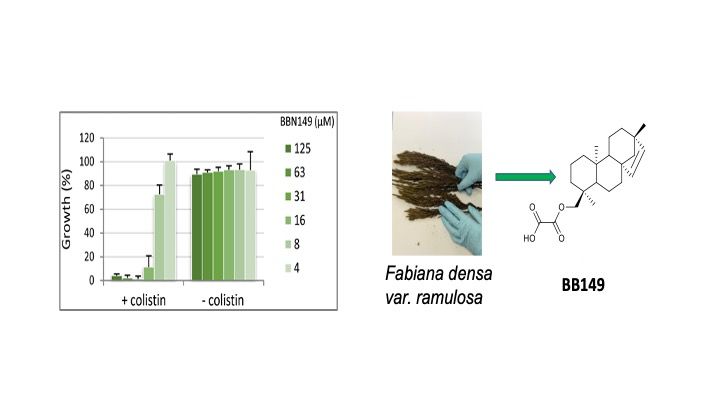
Fabiana ramulosa: a plant against antibiotic resistance
Antibiotic resistance is a mechanism that originates from the bacteria's natural defence system against external agents. At the molecular level, it is a process that generally occurs in a small number of the microorganisms of a bacterial population. However, when the population is exposed to antibiotics, those bacteria that are characterised by this resistance in order to survive and proliferate, quickly spread this capacity to other bacteria in the same ecosystem.
Antibiotic resistance is undermining the ability to treat the most common bacterial infections, putting even routine medical procedures such as surgery or chemotherapy at risk. The situation is also worsening with the emergence of new bacterial strains capable of developing resistance to multiple antibiotics (multi-resistance) and even pan-resistance to all available antibiotics. Just think of bacteria such as Klebsiella pneumoniae, Escherichia coli, Staphlylococcus aureus and Pseudomonas aeruginosa, which are widespread in all countries and show multiple resistance even to antibiotics indicated as a last resort, severely limiting the treatment options for patients.
For the treatment of infections caused by multi- or pan-resistant bacteria, old antibiotics have been reintroduced into treatments and, since they have not been used for several years, they may be effective. One of these is colistin, an antimicrobial molecule that went into disuse in the 1950s and has recently been reconsidered for the treatment of infections by Gram-negative bacteria such as Klebsiella.
Today, a new study coordinated by Sapienza University of Rome, in collaboration with other Italian universities and research institutions, has investigated the molecular mechanisms underlying the resistance of bacteria to colistin, identifying a natural compound capable of deactivating the action of bacteria against the drug.
The study, which is the result of the multidisciplinary approach of a team of chemists, bioinformaticians, microbiologists and biochemists, has been published on the Journal of Antimicrobial Chemotherapy and was supported by the MUR, the Italian Ministry of University and Research, the Italian Cystic Fibrosis Research Foundation and the Pasteur Institute-Cenci Bolognetti Foundation.
In particular, researchers have observed that colistin binds to the wall of bacteria, specifically to their lipidA component of lipopolysaccharide, and destroys its integrity by causing death. In bacteria that develop resistance to colistin, on the other hand, the enzyme ArnT is activated, which modifies lipidA, making it unassailable.
Knowledge of the molecular mechanisms at the basis of colistin resistance has therefore made it possible to identify BBN149, a compound of natural origin extracted from the Fabiana densa var. ramulosa plant, a genus of plants native to the mountain slopes of Chile and Argentina.
"Since in some cases colistin represents the last available therapeutic opportunity, it is essential to preserve its activity for as long as possible" − says Fiorentina Ascenzioni of the Department of Biology and Biotechnology "Charles Darwin" of Sapienza. "Our goal was to find a compound capable of inactivating ArnT, and we did so through the screening of a vast library of natural compounds belonging to Bruno Botta's group of the Department of Chemistry and Technology of Drugs of our University."
Later the researchers confirmed the function of BBN149, first with microbiological and biochemical data and then by using molecular modelling techniques, useful to simulate the behaviour of the molecule.
The experimental data presented in the paper on the one hand confirm ArnT as an anticolistin-resistance target, and on the other, pave the way for the development of colistin adjuvants in the treatment of bacterial Gram-negative colistin-resistant infections, which have rapidly increased since the molecule's use in antibiotics was restored.
References:
A novel colistin adjuvant identified by virtual screening for ArnT inhibitors − Francesca Ghirga, Roberta Stefanelli, Luca Cavinato, Alessandra Lo Sciuto, Silvia Corradi, Deborah Quaglio, Andrea Calcaterra, Bruno Casciaro, Maria Rosa Loffredo, Floriana Cappiello, Patrizia Morelli, Alberto Antonelli, Gian Maria Rossolini, Marialuisa Mangoni, Carmine Mancone, Bruno Botta, Mattia Mori, Fiorentina Ascenzioni, Francesco Imperi − Journal of Antimicrobial Chemotherapy, 2020, dkaa200. DOI https://doi.org/10.1093/jac/dkaa200
Further Information
Fiorentina Ascenzioni
Department of Biology and Biotechnology "Charles Darwin"
fiorentina.ascenzioni@uniroma1.it
Bruno Botta
Department of Chemistry and Technology of Drugs
bruno.botta@uniroma1.it
